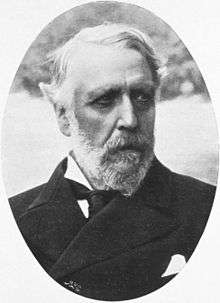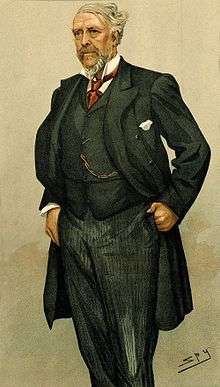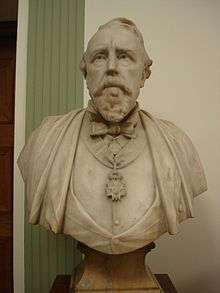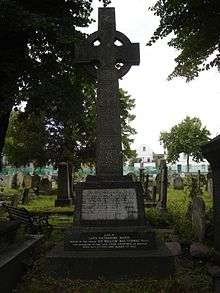William MacCormac
| Sir William MacCormac, 1st Baronet | |
|---|---|
 Sir William MacCormac, 1st Baronet | |
| Born |
William MacCormac 17 January 1836 Belfast |
| Died |
4 December 1901 (aged 65) Bath |
| Occupation | Surgeon |
| Language | English |
| Nationality | British Subject, |
| Education | Royal Armagh School, Queen's University |
| Spouse | Katherine Charters |



Sir William MacCormac, 1st Baronet KCB KCVO (17 January 1836 – 4 December 1901) was a notable British surgeon during the nineteenth and early twentieth centuries. MacCormac was a strong advocate of the antiseptic surgical methods proposed by Joseph Lister and he served in conflicts such as the Boer War. An advocate and pioneer of the Royal Army Medical Corps, MacCormac was perhaps the most decorated surgeon in Britain and he served as Serjeant Surgeon to Edward VII.
Early life and background
William MacCormac was born in Belfast, Ireland, the son of Dr Henry MacCormac, a notable Irish physician, and his wife Mary MacCormac (née Newsam), the daughter of a prominent Anglo-Irish family. Dr. Henry MacCormac was a well traveled physician and a lifelong proponent of the "open air theory" that stated that fresh air was conducive in order to prevent illnesses.
The MacCormac family was originally from County Armagh and descended from Cornelius MacCormac, a high-ranking Irish naval officer.
Education
MacCormac studied medicine and surgery at Belfast, Dublin and Paris, and graduated in arts, medicine and surgery at the Queen's University, Belfast, in which he afterwards became an examiner in surgery.
Career
He began practice in Belfast, where he became surgeon to the General Hospital, but left it for London on his marriage in 1861 to Miss Katherine M. Charters. In the Franco-Prussian War of 1870 he was surgeon-in-chief to the Anglo-American Ambulance, and was present at Sedan and he also went through the Turco-Servian War of 1876. He became in this way an authority on gunshot wounds, and besides being highly successful as a surgeon was a very popular in society, his magnificent physique and temperament making him a notable and attractive personality.
In 1881, he was appointed assistant-surgeon at St Thomas' Hospital, London and for twenty year continued his work here as a surgeon, lecturer and consulting surgeon. In 1881, he acted as honorary secretary-general of the International Medical Congress in London and was knighted for his services. In 1883 he was elected member of the council of college of surgeons and in 1887 a member of the court of examiners; in 1893 he delivered the Bradshaw lecture and in 1896 was elected president, being reelected to this office in 1897, 1998, 1899, and 1900 ( the centenary year of the college). In 1897, he was created a baronet, and appointed surgeon in ordinary to the Prince of Wales. His services were required the following year, when the Prince had an accident to his knee. MacCormac subsequently was appointed Knight Commander of the Royal Victorian Order (KCVO) in September 1898. In 1899, he was Hunterian Orator.
In the same year he volunteered to go out to South Africa as a consulting surgeon to the forces, and from November 1899 to April 1900 he saw much active service both in Cape Colony and Natal, his assistance being cordially acknowledged on his return when he became Knight Commander of the Order of the Bath (KCB) for his services.[1]
Later life
In February 1901, he was appointed honorary sergeant-surgeon to the King,[2] and in June 1901 he received an honorary doctorate (LL.D) from the University of Glasgow.[3] But, during 1898 he had suffered from prolonged illness and perhaps too much strain on his strength, for he died on 4 December 1901, somewhat suddenly at Bath.[4] He is buried with his wife, Lady Katherine Maria MacCormac (1835-1923), at Kensal Green Cemetery, London.
Personal life and family
In 1861, he married in Katherine Maria Charters (1835–1923), daughter of John Charters of Belfast. Although MacCormac had no issue from this union, he had numerous distinguished relatives. MacCormac's nephew, Dr. Henry MacCormac (1879 – 12 December 1950), was a successful dermatologist and the father of Sir Richard MacCormac, a notable modernist architect and the founder of MJP Architects.
Dr. William MacCormac was also the uncle of Sierra Leonean physician, Dr. John Farrell Easmon. When MacCormac served as a house surgeon to Queen Victoria, he invited Easmon to serve as his under study due to the latter's distinguished academic career. However Easmon turned MacCormac's offer and position down and instead chose to serve as a medical doctor in Freetown, Sierra Leone and the Gold Coast. Easmon was eventually promoted to the position of Chief Medical Officer of the Gold Coast in 1893.
Published works
Besides treaties on surgical operations, antiseptic surgery, and numerous contributions to the medical journals, MacCormac was the author of works under the Red Cross and of an interesting volume commemorating the centenary of the Royal College of Surgeons of England in 1900. The latter contains biographical notices of all the masters and presidents up to that date.
Honours
British orders and decorations
- KCVO: Knight Commander of the Royal Victorian Order – 1898
- KCB: Knight Commander of the Order of the Bath – 29 November 1900 – for services during the Second Boer War[1]
Foreign orders and decorations[4]
 : Officer of the Legion of Honour
: Officer of the Legion of Honour : Commander of the Order of the Dannebrog
: Commander of the Order of the Dannebrog_crowned.svg.png) : Commander of the Order of the Crown of Italy
: Commander of the Order of the Crown of Italy.svg.png) : Commander of the Order of Takovo
: Commander of the Order of Takovo.svg.png) : Order of the Crown
: Order of the Crown : Order of the Polar Star
: Order of the Polar Star.svg.png) : Order of Saint James of the Sword
: Order of Saint James of the Sword.svg.png) : Ritterkreuz of one of the Orders
: Ritterkreuz of one of the Orders : Order of Military Merit
: Order of Military Merit : Order of Medjidie
: Order of Medjidie
References
 This article incorporates text from a publication now in the public domain: Chisholm, Hugh, ed. (1911). "article name needed". Encyclopædia Britannica (11th ed.). Cambridge University Press.
This article incorporates text from a publication now in the public domain: Chisholm, Hugh, ed. (1911). "article name needed". Encyclopædia Britannica (11th ed.). Cambridge University Press.
- 1 2 The London Gazette: no. 27306. p. 2698. 19 April 1901.
- ↑ The London Gazette: no. 27289. p. 1414. 26 February 1901. Retrieved 14-10-2012.
- ↑ "Glasgow University jubilee". The Times (36481). London. 14 June 1901. p. 10.
- 1 2 "Death of Sir William MacCormac". The Times (36630). London. 5 December 1901. p. 11.
External links
| Wikimedia Commons has media related to Sir William MacCormac, 1st Baronet. |
-
 Works written by or about William MacCormac at Wikisource
Works written by or about William MacCormac at Wikisource - Biography
- D'A. Power, ‘MacCormac, Sir William, baronet (1836–1901)’, rev. Michael Worboys, Oxford Dictionary of National Biography, Oxford University Press, 2004,